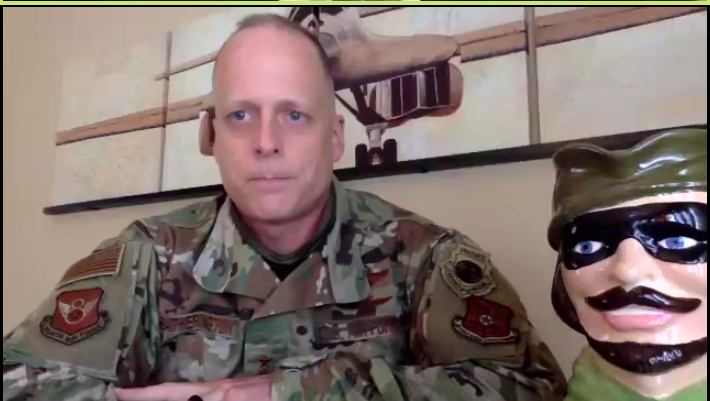
Maj. Gen. Mark Weatherington
WASHINGTON: The Air Force is still trying to craft its concept of operations (CONOPS) for hypersonic missiles — with the Air-launched Rapid Response Weapon (ARRW) providing the service’s first opportunity for real-world assessment.
Air Force Global Strike Command envisions a rolling wave of various hypersonic missile types hitting service inventories over the next few years as the service figures out how to employ such capabilities — with the ARRW leading as an “early to the fight” demonstrator, says Maj. Gen. Mark Weatherington, commander of the 8th Air Force and the Joint-Global Strike Operations Center.
“Obviously, they’re competing systems out there right now and I think everybody’s competing for the dollars that might be in this hypersonic capability area. But I think we will see kind of an uneven development. We’ll see some systems that are early to the fight — ARRW may be one of those to demonstrate some capability,” he told the Mitchell Institute today. “I think right now we’re learning. I think the ARRW is going to give us that first opportunity to learn.”
ARRW, a boost-glide powered missile, would be the first wave of hypersonics, followed by air-breathing missiles — including the Air Force Research Laboratory’s latest concept for a scramjet-powered missile to be carried on fighter jets. It’s being developed under the new Expendable Hypersonic Multi-Mission Air-Breathing Demonstrator (Mayhem) Program.
AFRL released a Request for Information (RFI) two weeks ago seeking industry responses by Sept. 25 outlining their interest and capabilities. AFRL is “interested in the design, fabrication, integration, and necessary research needed to enable a larger-scale expendable air-breathing hypersonic multi-mission flight demonstrator. The Mayhem System Demonstrator (MSD) will need to be capable of carrying larger payloads over distances further than current hypersonic capabilities allow. The payload bay will be modular and capable of carrying/delivering at least three distinct payloads in order to execute multiple Government-defined mission sets.”
The solicitation explains that Mayhem will bounce off earlier AFRL research activities under “the Enhanced Operational Scramjet Technology effort (Broad Area Announcement BAA-12-07-PKP), Enabling Technologies for High-speed Operable Systems (BAA-FA8650-17-S-2002), High Speed Strike Weapon Program, and Hypersonic Air-breathing Weapon Concept Program.”
As Breaking D readers know, the Hypersonic Air-breaking Weapon Concept (HAWC) is a DARPA effort with the Air Force as the ‘customer’ for the transition into a program of record.
Weatherington said that the rolling delivery of multiple types of hypersonic weapons is a “good thing” because it will allow the Air Force to figure out the best mix of those optimized for delivery by bomber aircraft and those optimized by fighters. There are, he said, a whole host of questions to be answered:
“How are we going to employ hypersonic weapons? What do they bring to the battlefield? What are our considerations for planning and executing and integrating them in a fight? … How do we understand the target, where it’s at, where it may be going, and make sure we can we can close that kill chain on a particular target?”
As Sydney and I reported back in April, the Air Force wants $554 million in research for its various hypersonic missile efforts: $172 million in an S&T pot (where Mayhem funds lie); and, $382 million for ARRW.
As with other senior Air Force leaders, Weatherington refused to be pinned down on just how many next-generation B-21 stealth bombers the Air Force believes it needs or the optimum size of the overall bomber force. A key issue is budgetary uncertainty and costs vs. benefits questions that he said will certainly require “a national debate.”
As Breaking D readers know, senior leaders including the head of Air Force Global Strike Command Gen. Timothy Ray, have been pushing for some time for the service to increase the officially planned buy of 100 B-21s, perhaps to as many as 145.
“But I would say my sense is the current force is too small to meet all the demands we place on it,” Weatherington added. “Air Force Global Strike Command is building decision points into the B-21 ramp … that would permit growth if required. And I think we’ll have to seriously look at it as we get farther down the stream of being bringing the B-21s online.”
While he wouldn’t be drawn on the expected initial operational capability (IOC) date for the B-21, he did reiterate that the Air Force does not see first flight before 2022.
Weatherington also noted the importance of the planned upgrades to the venerable B-52 Stratofortress fleet, which he said the service expects to cost around $3.5 million each. The goal is to keep the elderly bombers functioning until at least 2050. This includes the fierce contest for re-engining the aircraft — which pits Pratt & Whitney, GE Aviation and Rolls Royce against each other for a contract expected in 2021. While the service has not revealed the expected amount of the Commercial Engine Replacement Program (CERP), it is considered by the engine makers a high-stakes fight that will help prop up commercial sales lagging due to the COVID-19 pandemic and provide an income based for the next 17 years.
In a ‘world first,’ DARPA project demonstrates AI dogfighting in real jet
“The potential for machine learning in aviation, whether military or civil, is enormous,” said Air Force Col. James Valpiani. “And these fundamental questions of how do we do it, how do we do it safely, how do we train them, are the questions that we are trying to get after.”


























